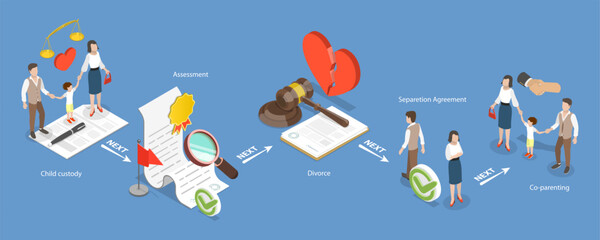First of all, we must know that divorce is a legal process that ends a marriage, and although laws vary from state to state, there are certain general steps that are common in most U.S. jurisdictions. This article will guide you through the most important aspects of the divorce process, including initial requirements, types of divorce, procedural steps, and key considerations such as child custody and asset division.
Initial Requirements for Divorce
Before starting a divorce process, it is crucial to understand the legal requirements of your state. These requirements include
- Residence:
Most states require that at least one of the spouses has resided in the state for a specified period, usually six months to a year. - Grounds for Divorce:
States recognize different grounds for divorce. These can be «no-fault» (such as irreconcilable differences) or «fault-based» (such as adultery, abuse, abandonment).

Types of Divorce
- No-Fault Divorce
In a no-fault divorce, neither party needs to prove the misconduct of the other spouse. It is simply declared that the marriage has ended due to irreconcilable differences or incompatibility. This type of divorce is the most common in the United States. - Fault-Based Divorce
In a fault-based divorce, one spouse must prove that the other committed an action justifying the divorce, such as adultery, physical or emotional abuse, abandonment, alcoholism, or drug addiction. These cases can be longer and more contentious as they require evidence and often witnesses. - Uncontested Divorce
Also known as an agreed divorce, it occurs when both spouses agree on all terms of the divorce, including the division of assets, child custody, and support. This type of divorce is generally faster and less expensive. - Contested Divorce
In a contested divorce, spouses cannot agree on one or more aspects of the divorce, requiring the court’s intervention to make decisions on these matters. This type of divorce can be emotionally exhausting and costly due to legal fees and court time.

Steps in the Divorce Process
Filing the Petition
The divorce process begins when one spouse files a divorce petition with the appropriate court. This document, often called the «Petition for Divorce» or «Dissolution of Marriage,» outlines the grounds for divorce and the initial demands of the filing party.
Service and Response
The spouse who files the petition must formally notify the other spouse. This process, called «service of process,» ensures the other spouse is aware of the legal proceedings. The notified spouse must file a response within a specific period (usually 30 days), in which they can agree, disagree, or make counterclaims.

Financial Disclosure
Both spouses must exchange detailed financial information. This process, known as «financial disclosure,» ensures that both have a complete understanding of the marital assets and liabilities, which is crucial for equitable distribution of property and determination of spousal or child support.
Negotiation and Settlement
In many cases, spouses and their attorneys will negotiate to reach an agreement on the divorce terms. This can include mediation, where a neutral third party helps the parties reach an agreement. If an agreement is reached, a document called a «Divorce Settlement Agreement» is drafted, specifying all agreed terms.
Trial
If spouses cannot reach an agreement, the case goes to trial. During the trial, both present their evidence and arguments to a judge, who will make decisions on the terms of the divorce. This can include asset division, child custody, and spousal or child support.
Divorce Decree
Once the judge makes a decision or the parties reach an agreement, the court issues a «Divorce Decree.» This document legally ends the marriage and details the rights and responsibilities of each party.

Child Custody and Support
- Child Custody
Child custody can be one of the most disputed aspects of divorce. Courts consider the best interests of the child when making custody decisions, evaluating factors such as stability, parents’ ability to provide care, and the child’s emotional and physical needs. Custody can be physical (where the child lives) and legal (who makes important decisions about the child). - Child Support
Child support is a periodic payment one parent must make to the other to cover child-rearing expenses. The amount is based on several factors, including both parents’ incomes, the time each spends with the child, and the child’s needs.
Division of Assets and Debts
Community Property vs. Separate Property
Asset division in a divorce depends on whether the state follows community property or equitable distribution laws. In community property states, all assets acquired during the marriage are considered joint property and are divided equally. In equitable distribution states, assets are divided fairly but not necessarily equally, considering factors such as the marriage’s duration and each spouse’s contributions
Marital Debts
Like assets, debts incurred during the marriage are generally considered joint responsibility and must be divided between the spouses.

Final Considerations
Finally, divorce is a complex and emotionally challenging process. It is crucial to have the support of legal and emotional professionals to navigate this transition. Family law attorneys can provide expert advice and legal representation, ensuring that your rights and those of your children are protected.
Additionally, resources like mediation and therapy can help manage emotional stress and facilitate a more harmonious resolution of conflicts. Taking the time to understand the process and seek appropriate support can make a significant difference in the final outcome and both parties’ ability to rebuild their lives after the divorce.
 Employeer and business Information about Employeers, plataforms and works
Employeer and business Information about Employeers, plataforms and works 



